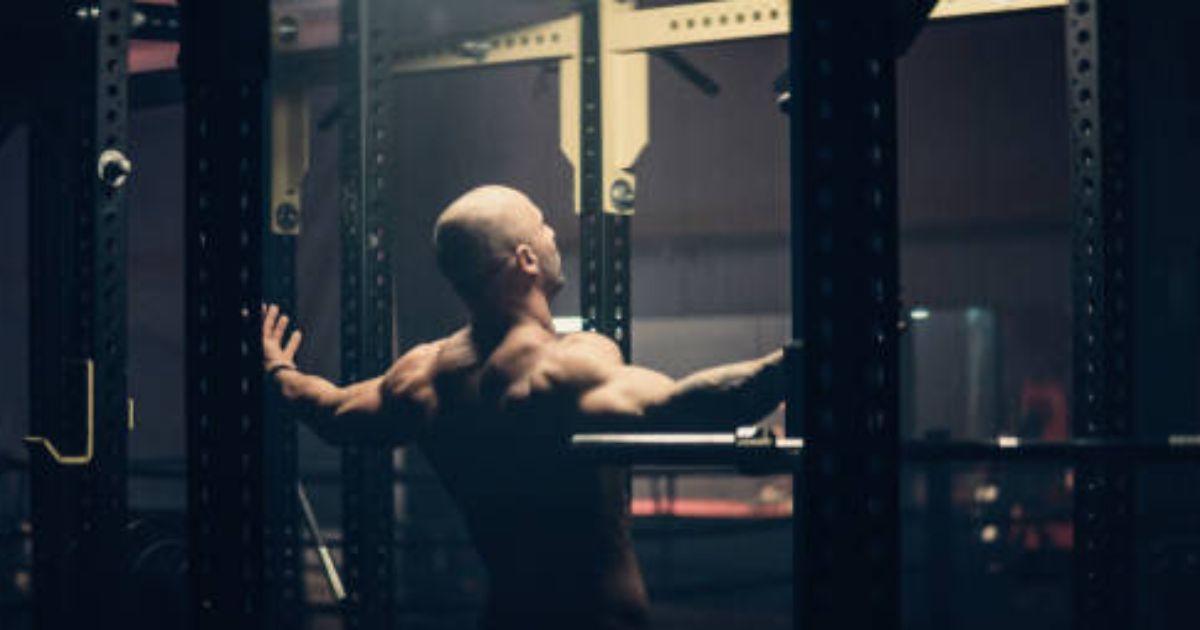Looking to get fit and shed some extra weight? Machine strength training exercises are your go-to solution!
These exercises are super easy to do and beginner-friendly which work wonders for toning muscles and burning calories.
They’re like your secret weapon for getting in shape without all the hassle.
Just hop on those machines, follow a few simple steps, and you’ll be well on your way to a fitter, healthier you.
So, let’s dive in and discover the best machine strength training exercises to help you reach your fitness goals.
How Machine Strength Training Exercises Help beginners to lose weight?
Machine strength training exercises are an incredibly effective way for beginners to get shredded and build muscle, and here’s why.
Firstly, every beginner should do machine exercises in the gym, because machines are made by considering each and every person, whether he/she is a newbie or advanced.
Machine strength training exercises help to build the foundation for strength training, as its beginner friendly which allows controlled and safe environment to learn proper form.
Secondly, when you do cardio, you burn the most calories doing it. But when you stop doing cardio, your calories stop burning.
We can call it a shoot-at-sight.
On the other hand, if you do machine strength training exercises, you will also burn calories after the workout. Like when you’re watching TV or relaxing on the couch.
Strength training will help you to become a calorie burning machine. This is because weight training helps you build muscle or lean muscle mass that is very metabolically active.
Finally, metabolism speeds up. This means that the more muscle you have, the more calories your body burns, even if you’re just lounging on the couch. It’s like a faster metabolism without extra work.
Another important benefit of machine strength training exercises is the afterburn effect, scientifically known as excess post-exercise oxygen consumption (EPOC).
After intense weight training, your body burns calories at a high rate for hours, sometimes up to 24 hours. This calorie burn will help you lose extra pounds more effectively than traditional cardio workouts.
So, if you’re ready to shred those fats and build a toned body, let’s dive into some killer machine strength training exercises.
Ready to get started? Let’s start with exercises.
Below there are numerous machine strength training exercises divided into each body part, the only means to create this list is to find those exercises which fit perfectly for you.
Let me explain, each person is different and so talking on that note you must pick only those exercises which help you in better gains.
Let’s take an example, when doing biceps curls, I feel mind muscle connection in the dumbbell curls and my workout buddy feels in the barbell curls.
Try each exercise like this week you perform biceps curls with dumbbells and on next try with machine and find which helps you in better pump and mind muscle connection.
Machine Strength Training Exercises
CHEST
1. Chest Press Machine:
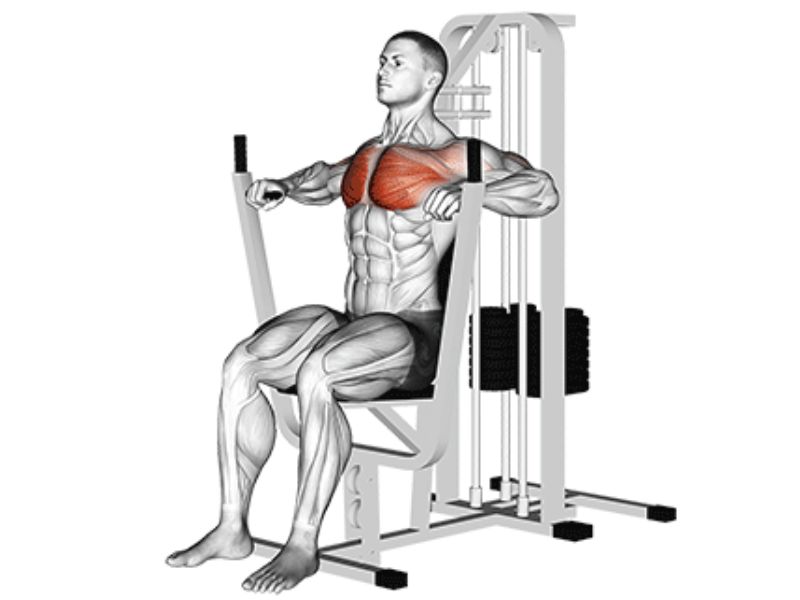
Steps:
- Sit on the machine with your back pressed firmly against the pad and core engaged. Adjust the seat height so your arms are slightly bent with elbows level with the handles when you grip them.
- Push the handles outwards until your arms are straight (but not locked) and squeeze your chest muscles at the top of the movement.
- Slowly bring the handles back towards your chest in a controlled manner.
Common Mistake: Arching your back or using momentum to push the weight.
Expert Tip: Maintain a neutral spine throughout the movement and focus on using your chest muscles to push the handles. Keep your core tight and avoid leaning back to compensate for the weight.
2. Incline Chest Press Machine:

Steps:
- Adjust the seat of the machine to an incline angle (usually between 30-45 degrees). Sit back with your back pressed firmly against the pad and core engaged. Adjust the handles so your arms are slightly bent with elbows level with the handles when you grip them.
- Push the handles outwards until your arms are straight (but not locked) and squeeze your upper chest muscles at the top of the movement.
- Slowly bring the handles back towards your chest in a controlled manner.
Common Mistake: Leaning forward or using your shoulders to press the weight.
Expert Tip: The incline position targets your upper chest muscles more than a flat bench press. Keep your core tight and focus on pushing with your chest, not your shoulders.
3. Chest Fly Machine:
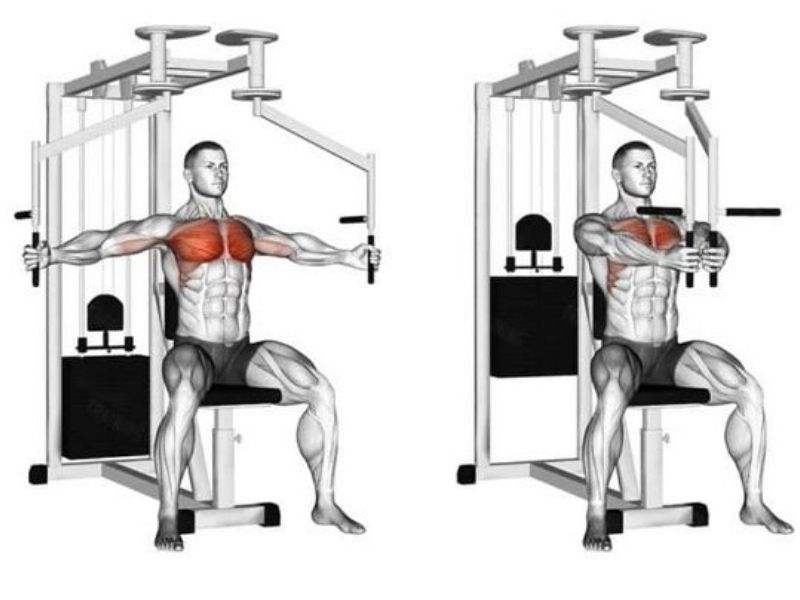
Steps:
- Sit on the machine and adjust the seat height so your arms are slightly bent when you grip the handles. Your elbows should be tucked in close to your sides throughout the movement.
- Open your arms outwards in a hugging motion, squeezing your chest muscles as you bring the handles together in front of your chest.
- Slowly return the handles back to the starting position in a controlled manner.
Common Mistake: Swinging the weight or letting your shoulders round forward.
Expert Tip: This exercise isolates your chest muscles for better definition. Focus on squeezing your chest with each rep and avoid using momentum to swing the handles. Keep your core tight and back straight.
4. Decline Chest Press Machine:
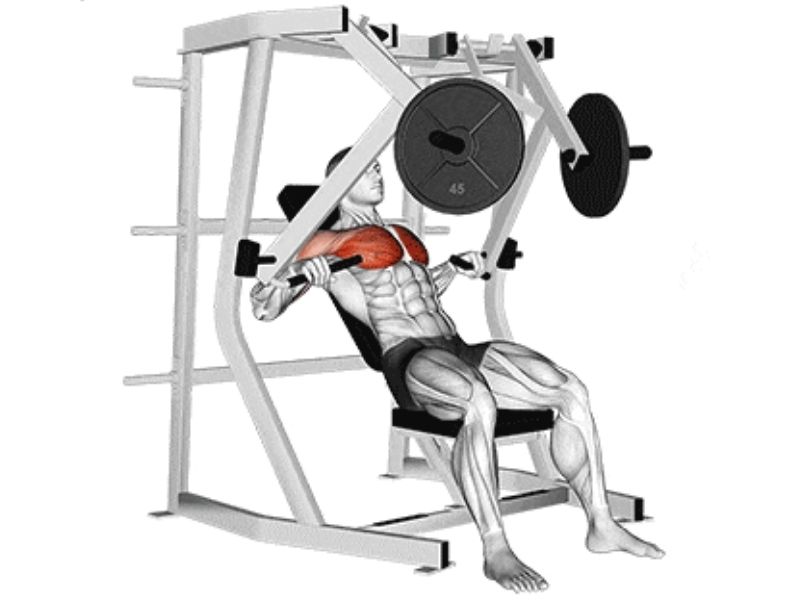
Steps:
- Adjust the seat of the machine to a decline angle (usually between 15-30 degrees). Lie back with your back pressed firmly against the pad and core engaged. Adjust the handles so your arms are slightly bent with elbows level with the handles when you grip them.
- Push the handles outwards until your arms are straight (but not locked) and squeeze your lower chest muscles at the top of the movement.
- Slowly bring the handles back towards your chest in a controlled manner.
Common Mistake: Arching your back excessively or using your shoulders to press the weight.
Expert Tip: The decline position targets your lower chest muscles more than a flat bench press. Keep your core tight, back pressed against the pad, and focus on pushing with your chest, not your shoulders.
5. Decline Chest Fly Machine:
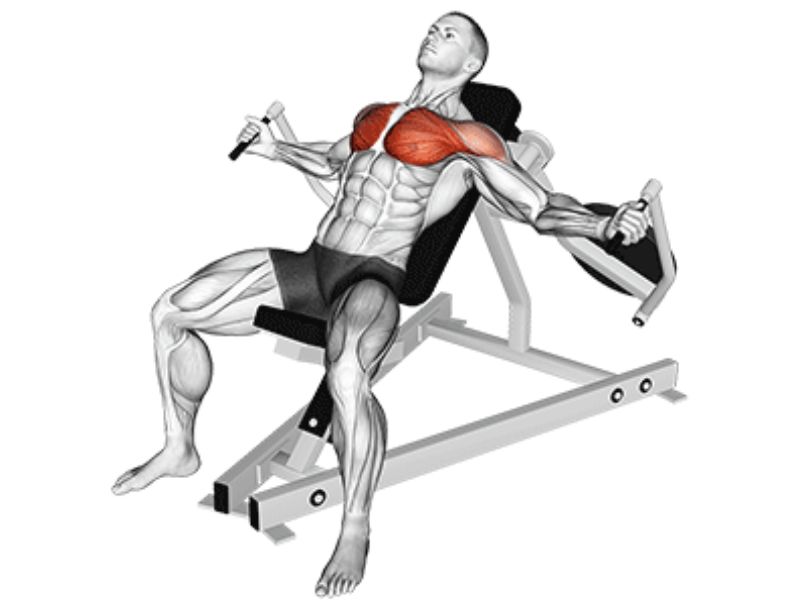
Steps:
- Adjust the seat of the machine to a decline angle (usually between 15-30 degrees). Sit back with your back pressed firmly against the pad and core engaged. Adjust the handles so your arms are slightly bent when you grip them. Your elbows should be tucked in close to your sides throughout the movement.
- Open your arms outwards in a hugging motion, squeezing your lower chest muscles as you bring the handles together below your chest.
- Slowly return the handles back to the starting position in a controlled manner.
Common Mistake: Leaning forward or using your shoulders round forward.
Expert Tip: Like the flat Pec Deck Fly, this exercise isolates your lower chest muscles. Maintain proper posture with your back pressed against the pad and avoid using momentum. Focus on squeezing your lower chest muscles with each rep and keep your core tight.
BACK
1. Machine High Rows:
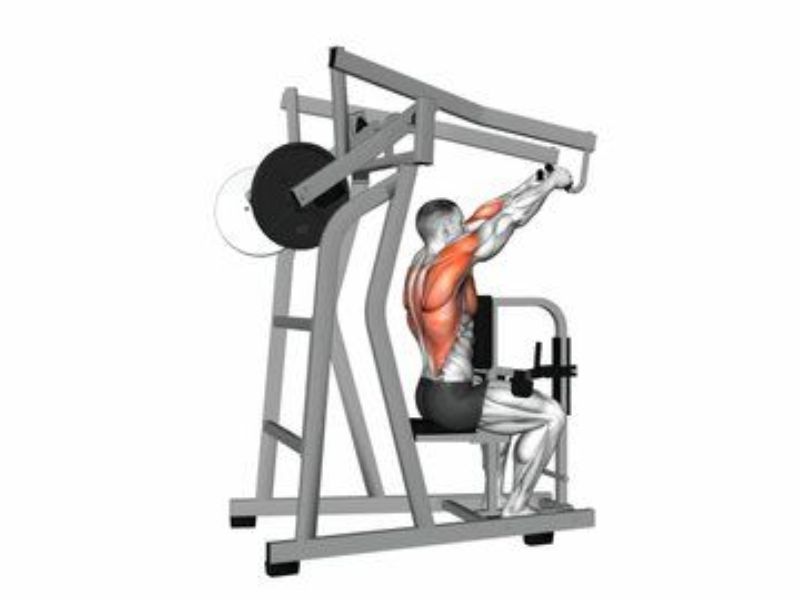
Steps:
- Sit on the machine and adjust the seat height so your knees are bent at a 90-degree angle and feet flat on the floor. Grasp the handles with a neutral grip (palms facing each other) or a pronated grip (palms facing down) depending on the machine.
- Pull the handles towards your chest, squeezing your shoulder blades together at the top of the movement. Imagine rowing a boat with good posture.
- Slowly release the handles back to the starting position in a controlled manner.
Common Mistake: Hunching your back or rounding your shoulders.
Expert Tip: Maintain a neutral spine throughout the movement and focus on using your back muscles to pull the handles. Keep your core tight and avoid hunching your shoulders forward.
2. Machine Low Rows:
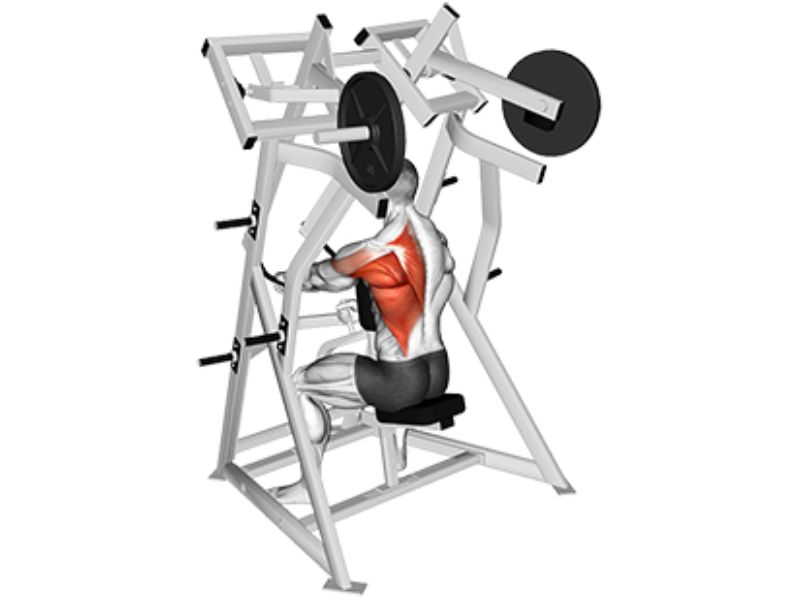
Steps:
- Adjust the seat of the machine so your thighs are nearly parallel to the floor and your torso is leaning forward slightly at an angle. Grasp the handles with a neutral grip (palms facing each other) or a pronated grip (palms facing down) depending on the machine.
- Pull the handles towards your lower abdomen, squeezing your mid-back muscles at the top of the movement. Imagine elbowing your ribs back.
- Slowly release the handles back to the starting position in a controlled manner.
Common Mistake: Arching your back or using your arms to pull the weight.
Expert Tip: Keep your core tight and back in a slightly angled position throughout the movement. Focus on pulling with your mid-back muscles, not your arms.
3. Machine Chest-Supported Rows:

Steps:
- Adjust the seat and chest pad of the machine for a comfortable and supported position. Grasp the handles with a neutral grip (palms facing each other) or a pronated grip (palms facing down) depending on the machine.
- Pull the handles towards your chest, squeezing your shoulder blades together at the top of the movement. Focus on maintaining proper form with the chest pad providing support.
- Slowly release the handles back to the starting position in a controlled manner.
Common Mistake: Using too much weight or neglecting smooth and controlled movement.
Expert Tip: This exercise is great for beginners to focus on proper rowing technique with chest support. Start with a lighter weight and prioritize controlled movement over heavy lifting.
4. Machine Lat Pulldowns:

Steps:
- Sit on the machine and adjust the leg pad for proper support. Grasp the bar with a wide grip (hands wider than shoulder-width apart) or a close grip (hands shoulder-width apart) depending on your desired back muscle focus.
- Pull the bar down towards your upper chest, squeezing your lats (latissimus dorsi) at the top of the movement. Imagine bringing your elbows down and together behind your back.
- Slowly release the bar back to the starting position in a controlled manner.
Common Mistake: Swinging your body or using momentum to pull the bar down.
Expert Tip: Keep your core tight and back straight throughout the movement. Focus on pulling with your lats, not using your lower back or arms to swing the weight.
5. Machine Pull-Ups:
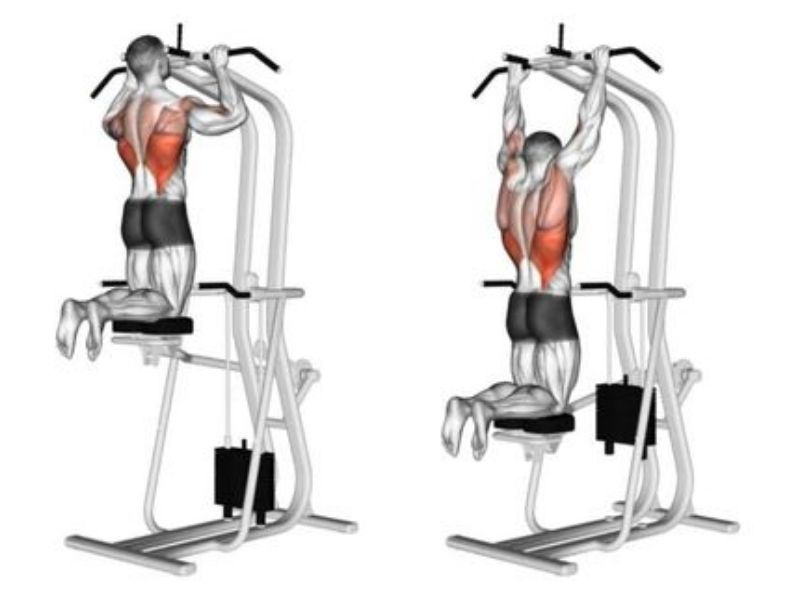
Steps:
- Adjust the seat height of the machine so your feet can comfortably support some of your body weight. Grasp the handles with a wide grip (hands wider than shoulder-width apart).
- Pull yourself up towards the handles, focusing on using your back muscles to initiate the movement. The machine will assist you in completing the pull-up.
- Slowly lower yourself back down to the starting position in a controlled manner.
Common Mistake: Relying solely on the machine’s assistance and not engaging your back muscles.
Expert Tip: This exercise is a great way to build back strength for beginners who can’t perform full pull-ups yet. Focus on engaging your back muscles as much as possible, even with the machine’s assistance.
SHOULDER
1. Machine Shoulder Press:
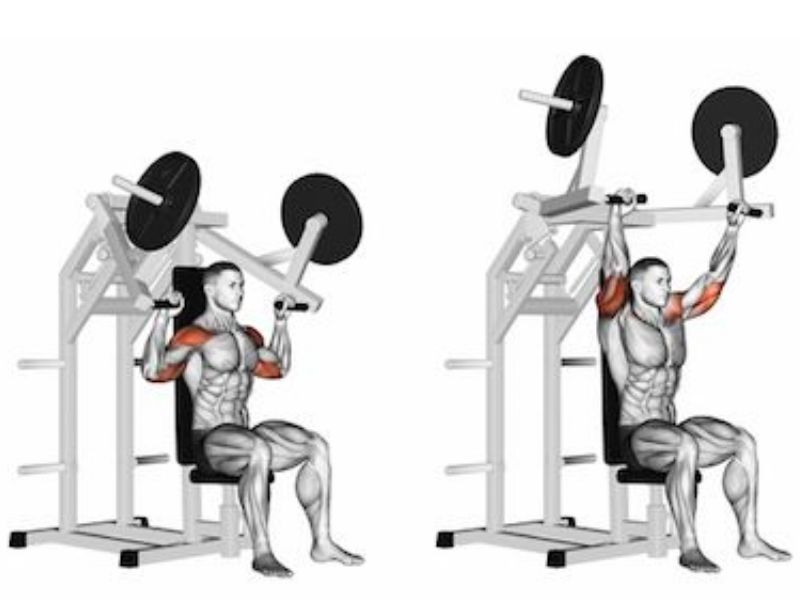
Steps:
- Sit on the machine and adjust the seat height so your back is pressed firmly against the pad and core engaged. Adjust the handles so your hands are slightly wider than shoulder-width apart with a neutral grip (palms facing each other).
- Push the handles upwards until your arms are straight (but not locked) and squeeze your shoulders at the top of the movement.
- Slowly lower the handles back down to the starting position in a controlled manner.
Common Mistake: Arching your back or leaning forward excessively.
Expert Tip: Maintain a neutral spine throughout the movement and focus on using your shoulders to press the weight upwards. Keep your core tight and avoid using momentum to swing the weight.
2. Machine Front Raise:
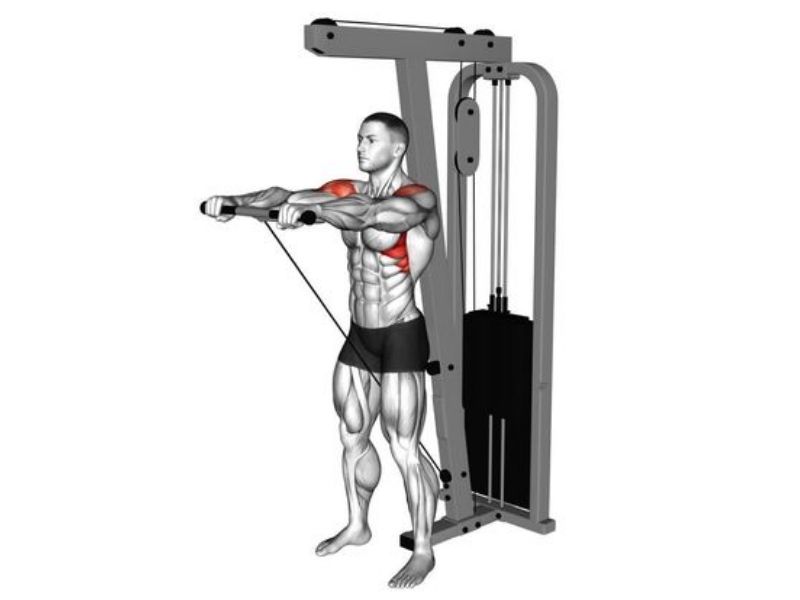
Steps:
- Sit on the machine and adjust the seat height so your arms are slightly bent when you grip the pads. Your elbows should be resting comfortably against the pads throughout the movement.
- Raise your arms forward until they are parallel to the floor, squeezing your front delt muscles (anterior deltoid) at the top of the movement. Imagine giving yourself a hug.
- Slowly lower the pads back down to the starting position in a controlled manner.
Common Mistake: Swinging the weight or using momentum to raise the pads.
Expert Tip: This exercise isolates your front delt muscles. Maintain proper posture with your back pressed against the pad and avoid using momentum. Focus on squeezing your front delts with each rep and keep your core tight.
3. Machine Lateral Raise:
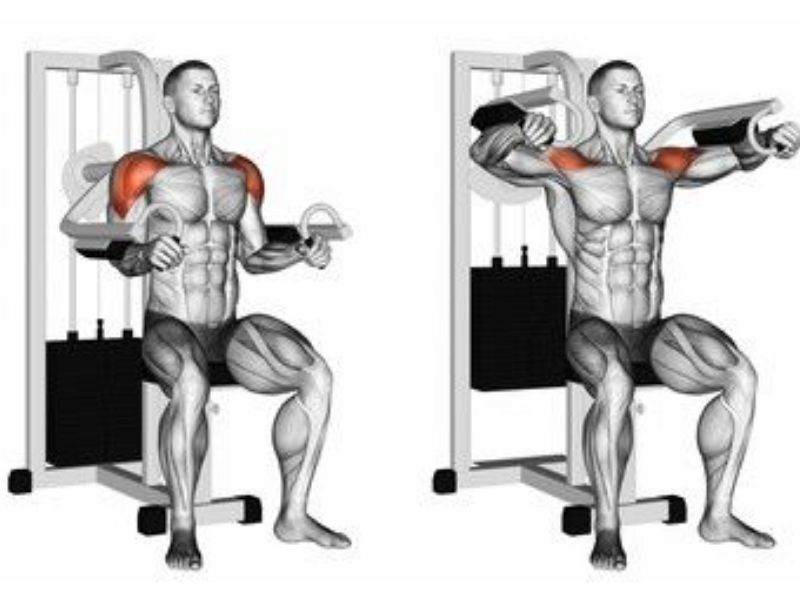
Steps:
- Sit on the machine and adjust the seat height so your arms are slightly bent when you grip the pads. Your elbows should be tucked in close to your sides throughout the movement.
- Raise your arms outwards to the sides until they are parallel to the floor (or slightly above), squeezing your side delt muscles (lateral deltoid) at the top of the movement. Imagine forming a “T” shape with your body.
- Slowly lower the pads back down to the starting position in a controlled manner.
Common Mistake: Leaning forward or using your shoulders to shrug the weight up.
Expert Tip: This exercise isolates your lateral delts, sculpting those side shoulder definitions. Keep your core tight, back straight, and focus on lifting the weight with your side delts, not using momentum or shrugging your shoulders.
4. Machine Upright Row:
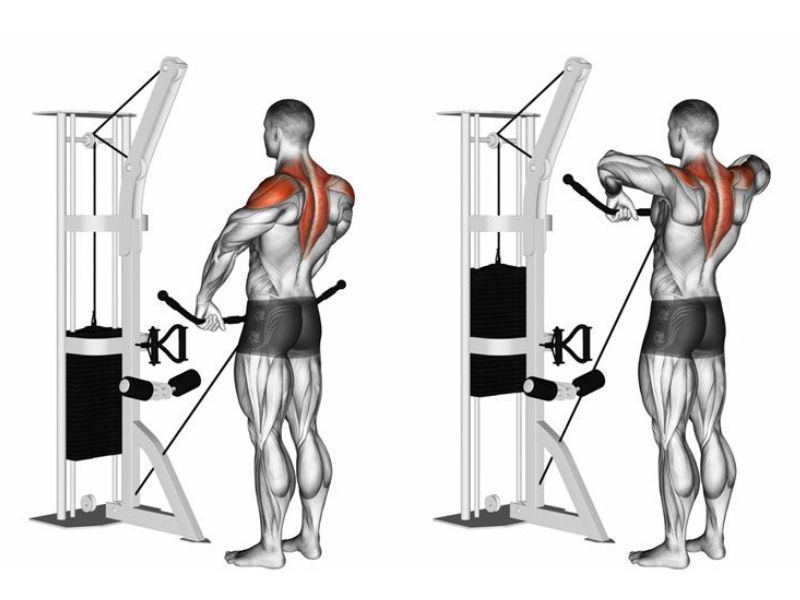
Steps:
- Sit on the machine and adjust the seat height so your back is pressed firmly against the pad and core engaged. Grasp the handles with a neutral grip (palms facing each other) and start with your hands close together at the bottom.
- Pull the handles upwards in a vertical plane towards your shoulders, squeezing your upper back and traps muscles at the top of the movement. Imagine shrugging your shoulders upwards but with a slight inward motion. Note: This exercise can put stress on your shoulders if not done with proper form. Consider alternatives like Machine High Rows (explained earlier) if you’re a beginner.
Common Mistake: Swinging the weight or using momentum to pull the handles. Rounding your back can also occur.
Expert Tip: This exercise targets your upper back and traps muscles along with your shoulders. Maintain a neutral spine and avoid using momentum. Keep your core tight and focus on controlled movement throughout the rep. Use caution with this exercise, especially if you have any shoulder issues.
5. Machine Shoulder Shrug:
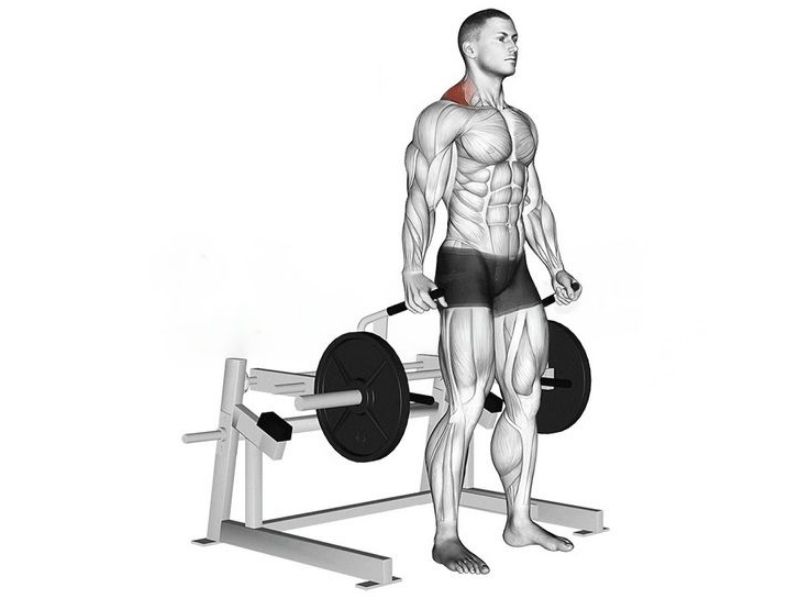
Steps:
- Sit on the machine and adjust the seat height so your shoulders are comfortably positioned under the pads. Rest your shoulders on the pads and grasp the handles with a neutral grip (palms facing each other).
- Shrug your shoulders upwards, squeezing your traps muscles (upper back) at the top of the movement. Imagine pulling your shoulders towards your ears.
- Slowly lower your shoulders back down to the starting position in a controlled manner.
Common Mistake: Lifting your entire body off the seat or using your arms to pull the weight.
Expert Tip: This exercise isolates your traps muscles for pure shoulder shrugs. Keep your core tight, back straight, and focus on shrugging your shoulders upwards without using your arms or lower back.
LEGS
1. Leg Press Machine:

Steps:
- Sit on the machine and adjust the seat back so your knees are bent at a 90-degree angle when your feet are flat on the platform (similar to sitting in a chair).
- Place your feet shoulder-width apart on the platform and engage your core.
- Push the platform away from you by extending your legs, but don’t lock your knees at the top. Squeeze your glutes and hamstrings at the top of the movement.
- Slowly lower the platform back down to the starting position in a controlled manner.
Common Mistake: Arching your back or using momentum to push the weight.
Expert Tip: Maintain a neutral spine throughout the movement and focus on using your glutes and hamstrings to push the platform. Keep your core tight and avoid arching your back to compensate for the weight.
2. Leg Extension Machine:
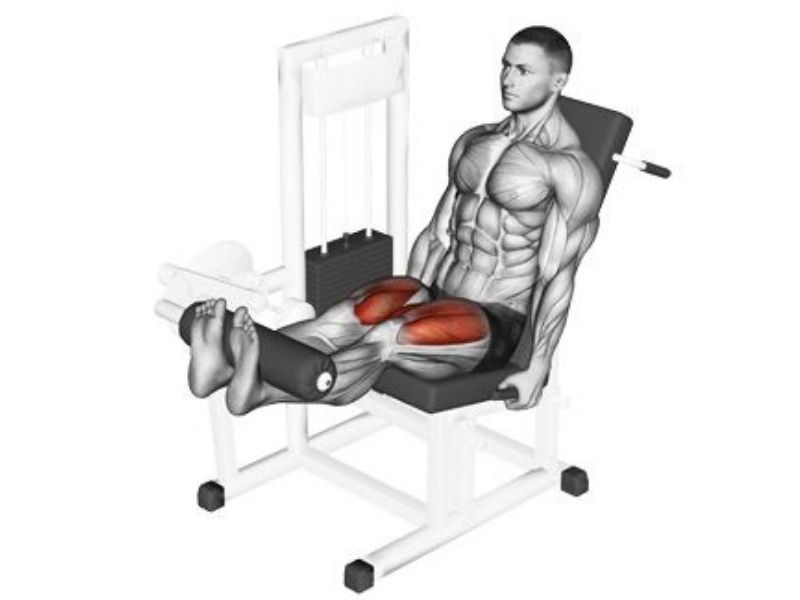
Steps:
- Sit on the machine and adjust the seat height so the pad rests just above your shins. Secure your ankles under the pad and engage your core.
- Extend your legs straight out in front of you, squeezing your quadriceps muscles (quads) at the top of the movement.
- Slowly lower your legs back down to the starting position in a controlled manner.
Common Mistake: Using too much weight or not focusing on full range of motion.
Expert Tip: This exercise isolates your quads. Start with a lighter weight and focus on extending your legs fully at the top and bringing them back down to a comfortable starting point, not forcing your knees to hyperextend.
3. Leg Curl Machine:
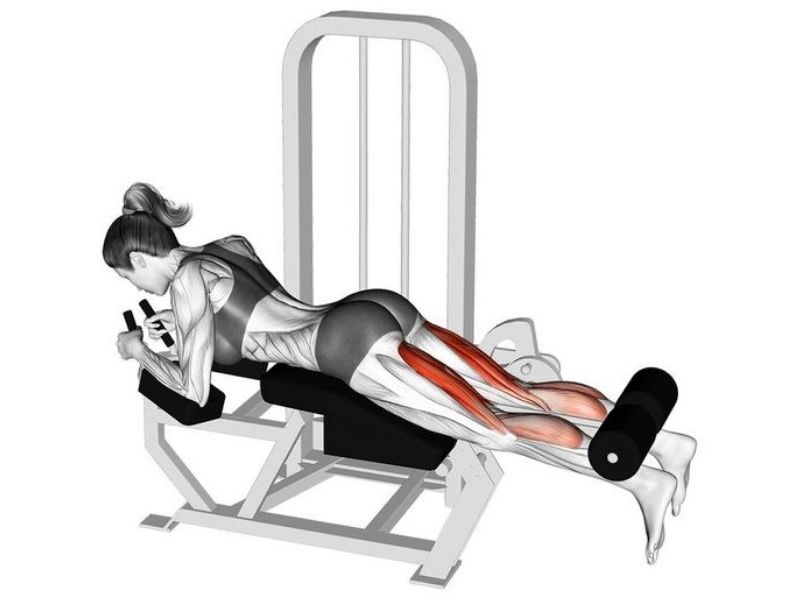
Steps:
- Lie face down on the machine and adjust the pad so it sits comfortably behind your calves. Secure your ankles under the pad and engage your core.
- Curl your heels towards your glutes, squeezing your hamstring muscles at the top of the movement.
- Slowly lower your heels back down to the starting position in a controlled manner.
Common Mistake: Arching your back or using your lower back to pull the weight.
Expert Tip: This exercise isolates your hamstrings. Keep your back pressed flat against the pad throughout the movement and focus on curling your heels towards your glutes with your hamstrings, not using your lower back.
4. Squat Machine:
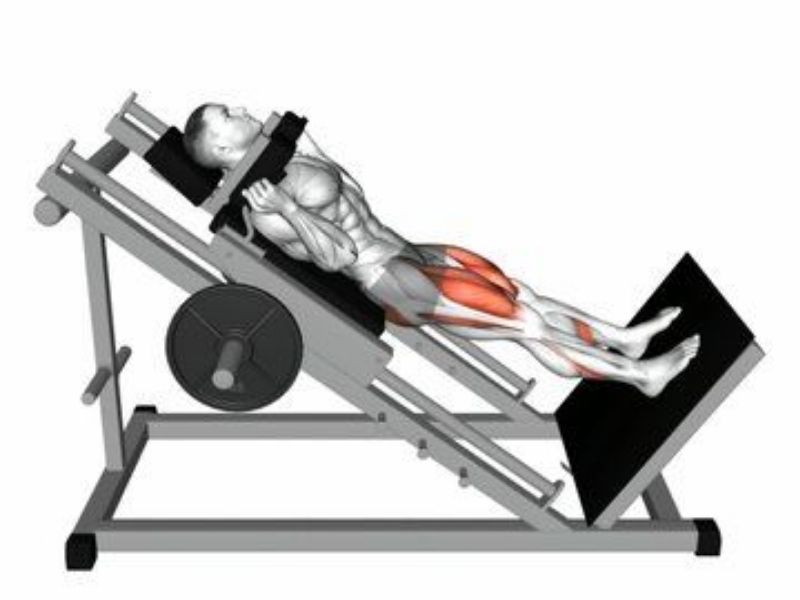
Steps:
- Adjust the seat and pad height of the machine so your thighs are parallel to the floor (or slightly below) when you sit back with your back pressed firmly against the pad. Place your feet shoulder-width apart on the platform and engage your core.
- Push the platform down with your legs, extending them and standing up straight. Squeeze your glutes and quads at the top of the movement.
- Slowly lower yourself back down to the starting position in a controlled manner.
Common Mistake: Leaning forward or not squatting low enough to engage your glutes.
Expert Tip: The squat machine provides a guided movement for beginners who might struggle with free squats. Keep your core tight, back pressed against the pad, and focus on squatting down low enough to feel a stretch in your hamstrings, while keeping your back straight.
5. Calf Raise Machine:
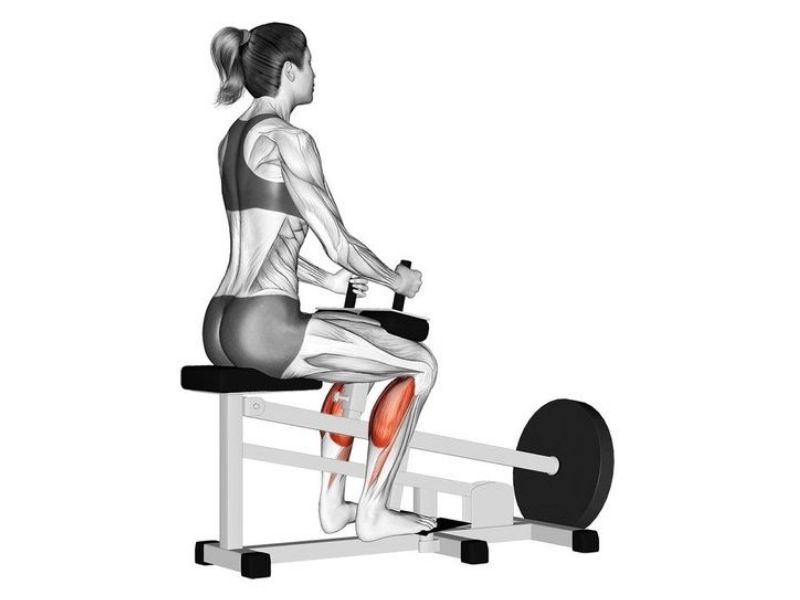
Steps:
- There are two common variations – seated and standing calf raises. Choose the machine that feels most comfortable for you.
- Adjust the weight stack or pad height for a proper starting position. For seated calf raises, place the balls of your feet on the platform with your heels hanging off the edge. For standing calf raises, position your entire foot on the platform.
- Raise your heels up as high as you comfortably can, squeezing your calf muscles at the top of the movement. Hold for a second before slowly lowering your heels back down to the starting position in a controlled manner.
Common Mistake: Not raising your heels high enough or using too much weight.
Expert Tip: This exercise isolates your calf muscles. Focus on raising your heels through their full range of motion and avoid using momentum to swing the weight. Start with a lighter weight and prioritize feeling the contraction in your calves with each rep.
BICEPS
1. Machine Preacher Curls:
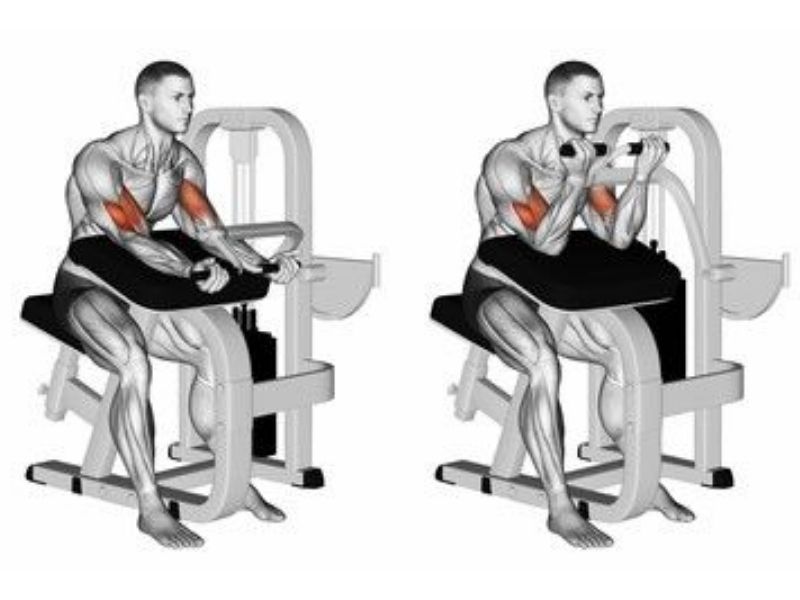
Steps:
- Adjust the pad of the machine so your elbows are bent at a 90-degree angle and your upper arms are comfortably resting against the pad. Secure your chest against the pad and engage your core.
- Grip the handles with a neutral grip (palms facing each other) and curl your forearms upwards, squeezing your biceps muscles at the top of the movement. Imagine flexing your bicep to bring your hand towards your shoulder.
- Slowly lower the handles back down to the starting position in a controlled manner.
Common Mistake: Arching your back or using momentum to swing the weight.
Expert Tip: This exercise isolates your biceps, allowing for targeted development. Keep your core tight, back pressed against the pad, and focus on curling the weight with your biceps, not using your body momentum.
2. Machine Hammer Curls:
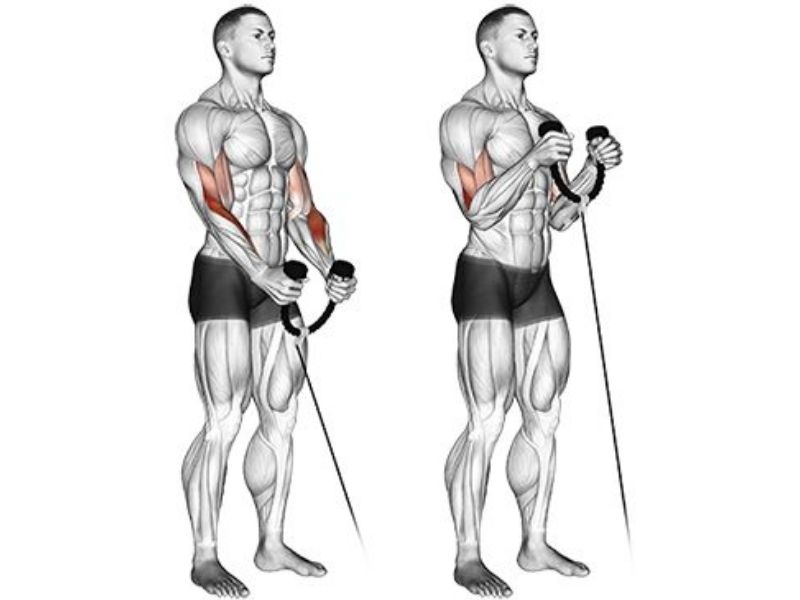
Steps:
- Sit on the machine and adjust the seat height so your arms are slightly bent when you grip the handles. Your elbows should be resting comfortably against the pads throughout the movement. The handles will be in a neutral position (palms facing each other).
- Curl your forearms upwards towards your shoulders, squeezing your biceps muscles at the top of the movement. Imagine flexing your bicep while keeping your forearms vertical.
- Slowly lower the handles back down to the starting position in a controlled manner.
Common Mistake: Not maintaining a neutral grip or letting your elbows flare out to the sides.
Expert Tip: The neutral grip variation of curls can be easier on the wrists and elbows for some people. Keep your elbows tucked in close to your sides throughout the movement and focus on squeezing the weight up with your biceps, maintaining that neutral hand position.
3. Machine Concentration Curls:

Steps:
- Adjust the arm pad of the machine so your inner arm is resting comfortably against it. Sit on the seat and grip the handle with a neutral grip (palms facing each other).
- Curl your forearm upwards towards your shoulder, squeezing your bicep muscle at the top of the movement. Imagine flexing your bicep to bring your hand towards your chest.
- Slowly lower the handle back down to the starting position in a controlled manner.
Common Mistake: Leaning forward or using your body to swing the weight.
Expert Tip: This exercise isolates the peak of your biceps muscle. Maintain an upright posture with your core engaged and focus on curling the weight with your bicep, not using body momentum.
4. Machine Standing Curls:
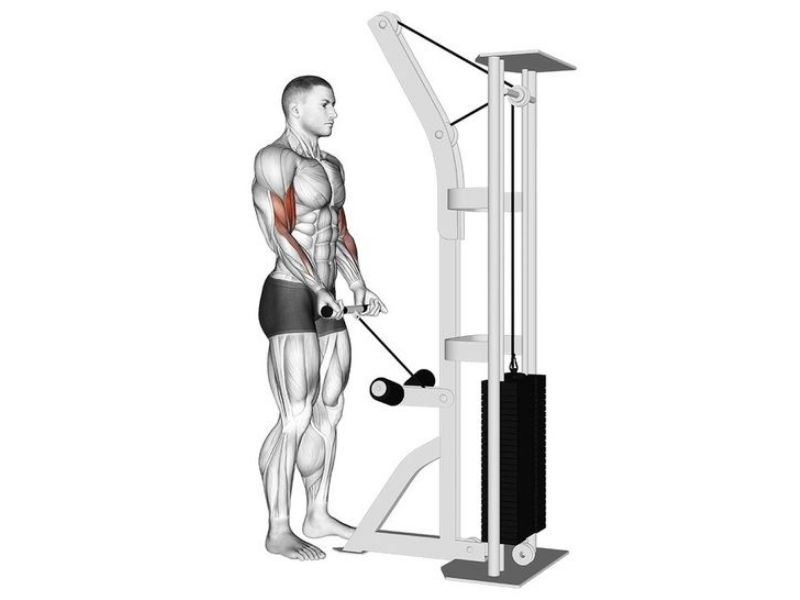
Steps:
- Adjust the seat height of the machine so you can stand comfortably with your back pressed against the pad and core engaged. Grip the handles with a supinated grip (palms facing up).
- Curl your forearms upwards towards your shoulders, squeezing your biceps muscles at the top of the movement. Imagine flexing your bicep to bring your hand towards your shoulder.
- Slowly lower the handles back down to the starting position in a controlled manner.
Common Mistake: Swinging your body or using momentum to lift the weight. Leaning back can also occur.
Expert Tip: This exercise provides a more complete bicep workout. Keep your core tight, back pressed against the pad, and focus on curling the weight with your biceps, not using momentum or arching your back.
TRICEPS
1. Machine Overhead Tricep Extension:
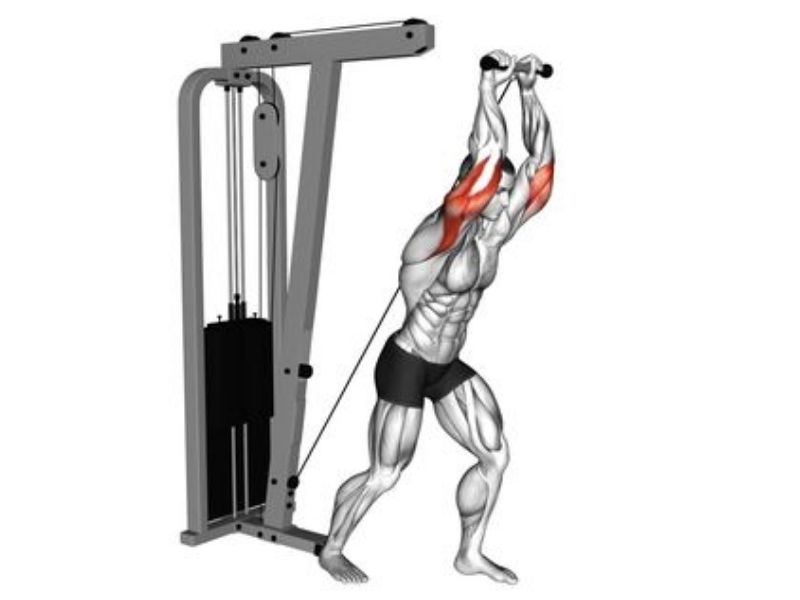
Steps:
- Sit on the machine and adjust the seat height so your back is pressed firmly against the pad and core engaged. Adjust the handles so your arms are slightly bent with elbows tucked in close to your sides. Grip the handles with a neutral grip (palms facing each other).
- Push the handles upwards until your arms are straight (but not locked) and squeeze your triceps at the top of the movement. Imagine pushing the ceiling away with your forearms.
- Slowly lower the handles back down to the starting position in a controlled manner.
Common Mistake: Arching your back or using momentum to swing the weight. Letting your elbows flare out to the sides is also common.
Expert Tip: This exercise isolates your triceps, allowing for targeted development. Keep your core tight, back pressed against the pad, elbows tucked in, and focus on pushing the weight up with your triceps, not using your body momentum.
2. Machine Skull Crushers:
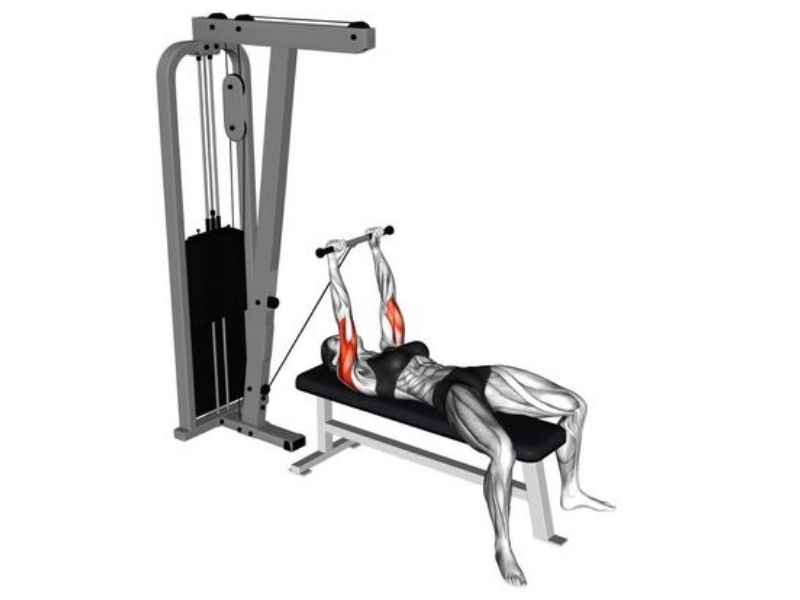
Steps:
- Adjust the pad of the machine so your upper arms are resting comfortably against it, with elbows bent at a 90-degree angle. Secure your head and chest against the pad and engage your core. Grip the handles with a neutral grip (palms facing each other). Note: This exercise can put stress on your elbows if not done with proper form. Consider alternatives like Machine Overhead Tricep Extensions if you’re a beginner.
- Slowly lower the handles down towards your head, keeping your upper arms stationary and squeezing your triceps at the bottom of the movement.
- Slowly raise the handles back up to the starting position in a controlled manner.
Common Mistake: Lowering the weight too far behind your head or letting your elbows flare out.
Expert Tip: This exercise is for more advanced exercisers due to the potential for elbow strain. Maintain a tight core, keep your upper arms locked in position, and focus on lowering and raising the weight with control, not letting your elbows move. If you feel any pain, stop this exercise immediately.
3. Machine Tricep Kickbacks:

Steps:
- Adjust the seat and pad height of the machine so your arm can rest comfortably against the pad. Grip the handle with a neutral grip (palms facing each other).
- Extend your arm straight back with a slight bend at the elbow, squeezing your triceps at the top of the movement. Imagine pushing your hand backwards to squeeze a tennis ball.
- Slowly lower your arm back down to the starting position in a controlled manner. Repeat for the other arm.
Common Mistake: Leaning forward or using your back to help lift the weight.
Expert Tip: This exercise isolates each tricep for focused development. Maintain an upright posture with your core engaged and focus on extending your arm back with your tricep, not using your body to swing the weight.
4. Machine Tricep Dips:

Steps:
- Adjust the seat and chest pad of the machine for a comfortable and supported position. Grip the handles with a neutral grip (palms facing each other).
- Lower your body down by bending your elbows, keeping your core tight and back pressed against the pad. Squeeze your triceps at the bottom of the movement.
- Push yourself back up to the starting position in a controlled manner.
Common Mistake: Leaning forward or not lowering yourself down far enough to engage your triceps fully.
Expert Tip: This variation of tricep dips provides support for beginners who might struggle with regular dips. Keep your core tight, back pressed against the pad, and focus on lowering yourself down until your elbows are bent at a 90-degree angle to maximize tricep engagement.
What are some common mistakes to avoid when using machine Strength Training Exercises?
Machine strength training exercises offers a fantastic way to build strength and confidence, especially for beginners.
Whether you’re new to the gym or a seasoned lifter, avoiding these common mistakes will help you get the most out of your workouts and keep your injury-free.
Let’s get in.
A. Improper Form and Technique

Entering the gym and seeing people of the same age setting the machine to heavy weight and which hits your ego and you also started to lift heavily.
It is known as ego lifting. It is just like not gaining anything for yourself and showing others that i can lift heavy weights.
Eventually not focusing on proper form and techniques, which can cause you injuries and let you sit at home for months or years.
Not only does proper form and technique help you to stay away from injury, but it also leads to better gains.
So, pick the weights which allow you to get 10-12 reps with proper and controlled form.
Here is a tip: to get proper form you must do higher reps of lower weight, as it will allow you to empower the weights rather than the weights empowering you.
With that don’t forget to increase weight gradually while maintaining the form.
B. Neglecting Warm-Up and Cool-Down

When we are on a rest our muscles are also resting also your blood pressure is running at a lower speed.
But suddenly you gave your body a shock by starting strength training exercises, it can lead to straight spike in the blood pressure as well as your heart.
Which can cause you serious injuries.
Thats why doing warm-up or even a little warm-up will make you ready to workout. When engaging in a little cardio or stretching it will allow your body to get away from rest motion and allow the blood to flow entirely your body in a better flow.
Likewise, cool down also plays an important role. As we discussed during the workout, your blood flow and heart rate spikes up.
A proper cool-down helps facilitate the return of your heart rate and breathing to their resting levels, promotes the removal of metabolic waste products from the muscles, and prevents blood from pooling in the extremities.
Stretching as part of your cool-down routine helps improve flexibility by elongating the muscles that may have contracted during exercise. This can help reduce muscle stiffness and soreness, enhance range of motion, and improve overall muscle function.
Conclusion
In summary, machine strength training exercises offer an effective path to weight loss and improved fitness.
By focusing on proper form, avoiding common mistakes like lifting too heavy too soon, and always warming up and cooling down, you can maximize results while reducing the risk of injury.
Stay consistent and celebrate progress along the way. With dedication, you’ll achieve a stronger, healthier, and more confident you.

